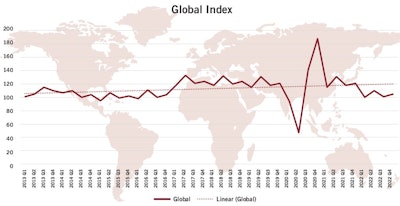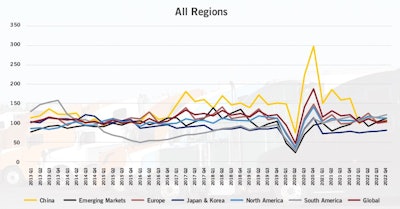
The Power Systems Research Truck Production Index (PSR-TPI) increased from 101 to 105, or 3.7%, for the three-month period ended December 31, 2022, from Q3 2022. The year-over-year (Q4 2021 through Q4 2022) loss for the PSR-TPI was, 122 to 105, or -13.2%.
The PSR-TPI measures truck production globally and across six regions: North America, China, Europe, South America, Japan & Korea and Emerging Markets. This data comes from OE Link, the proprietary database maintained by Power Systems Research.
Global Index
Global medium and heavy vehicle production is expected to decline by 15.8% in 2022 when final numbers are available in Q1 2023, primarily due to a significant drop in heavy truck demand in China. Global MHCV demand is expected to improve by 4.6% in 2023 even with concerns of a slowing global economy. Ongoing supply chain disruptions along with generally higher inflation and a risk of Covid variants returning are also a concern moving forward.  Global medium and heavy vehicle production is expected to decline by 13% this year primarily due to a significant drop in heavy truck demand in China. A slowing global economy along with continued supply chain disruptions will continue place pressure on demand moving forward.Power Systems Research
Global medium and heavy vehicle production is expected to decline by 13% this year primarily due to a significant drop in heavy truck demand in China. A slowing global economy along with continued supply chain disruptions will continue place pressure on demand moving forward.Power Systems Research
All Regions
Medium and heavy commercial vehicle production will be mixed in 2022 due to a variety of issues. In China, truck overcapacity continues to hinder demand while the Russian-Ukraine war is significantly impacting demand and production in Eastern Europe.
While the global supply chain is showing improvement, it will remain a problem in 2023 for all regions. There is serious concern about a major slowdown in the North American and European economy as a direct result of higher fuel and energy prices and overall inflation which doesn’t appear to be going away anytime soon. Medium and heavy commercial vehicle production will be mixed this year due to a variety of issues. In China, truck overcapacity continues to hinder demand while the Russian-Ukraine war is significantly impacting demand and production in Eastern Europe. The global supply chain will remain a problem through at least the end of this year for all regions. There is serious concern about a major slowdown in the North American and European economy as a direct result of higher fuel and energy prices and overall inflation which doesn’t appear to be going away anytime soon.Power Systems Research
Medium and heavy commercial vehicle production will be mixed this year due to a variety of issues. In China, truck overcapacity continues to hinder demand while the Russian-Ukraine war is significantly impacting demand and production in Eastern Europe. The global supply chain will remain a problem through at least the end of this year for all regions. There is serious concern about a major slowdown in the North American and European economy as a direct result of higher fuel and energy prices and overall inflation which doesn’t appear to be going away anytime soon.Power Systems Research
North America
Medium and heavy commercial vehicle production is expected to increase by 12.5% in 2022 over last year primarily driven by improved class 8 truck production. While not back to pre-pandemic levels, the
supply chain has seen improvement during the past few months. Within the class 8 truck segment, PSR expects truck demand to remain strong into the first part of next year as a result of significant pent-up heavy truck demand.
While commercial vehicle demand is expected to decline slightly in 2023, production levels are expected to remain strong through at least the first half of the year.
Europe
Commercial vehicle production is expected to improve by 2.3% in 2022 over 2021 and further improve by 4.8% in 2023 primarily due to continued pent up vehicle demand. However, higher inflation, particularly energy costs and higher interest rates along with continued supply chain issues will put negative pressure on demand throughout the year. Another concern is the ability of the various manufacturing plants to remain open during possible power shortages.
South Asia
After relatively low vehicle demand over the past few years, medium and heavy commercial vehicle demand in South Asia continues to be strong and production is expected to rise by 18.6% in 2022.
over 2021. Production is expected to further increase by 12.9% in 2023 as the trucking companies continue to replace their older vehicles. In India, the focus is moving toward more infrastructure spending which is good for the vocational market.
South America
After exceedingly elevated levels of MHCV production in Brazil in 2021, overall production in South America is expected to increase by 6% in 2022 before declining by 11.7% this year. Emission regulations
Proconve 8 or P8, equivalent to Euro VI, are now in effect in Brazil. The legislation considers MHV to be all CV vehicles above 3.8 tons. The additional vehicle cost of the P8 emission technology will likely have a negative impact on Brazilian truck demand this year. Other factors such as higher interest rates will also place pressure on truck demand moving forward.
Japan & Korea
Medium and heavy commercial vehicle production in Japan and South Korea is expected to finish flat in 2022 compared to 2021. However, commercial vehicle production is expected to increase by 4.8% this year. Concerns surrounding a slowing global economy along with continued supply chain disruptions will likely impact vehicle demand this year.
Greater China
Demand for medium and heavy commercial vehicles declined sharply in 2022 primarily due to a slowing economy and the affects from Covid related lockdowns. Also impacting demand was the implementation of the vehicle scrappage scheme in 2020 and 2021 along with a truck prebuy ahead of the China VI emission regulations implemented in July 2021 which resulted in a relatively young truck fleet in China. MHCV production is expected to improve by 7.7% this year over 2022.
The next update of the Power Systems Research TPI will be in April 2023 and will reflect changes in the TPI during Q1 2023.
Learn more from this report.


















